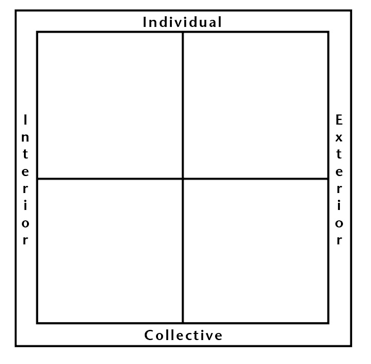Integral Theory
Episode #10 of the course 10 tools for change by Kate Sutherland
You’ve almost done it—given yourself ten tools for creating change, from self to system, that is!
The last one, Integral Theory, is one of the “sharpest” in that it offers the most distinctions by far. It is, after all, an attempt to be “integral”—to cover everything that is essential.
Origin
Integral Theory is the brainchild of Ken Wilber, a one-of-a-kind philosopher who has written over 20 books, including A Theory of Everything. One of Wilber’s great contributions has been mapping all the dimensions of human knowledge and experience into one framework (Integral Theory), from subatomic particles to galaxies and from every “ology” in the social sciences to business, ethics, and spirituality.
Let’s dive in where his famous book, Sex, Ecology and Spirituality, begins.
Holons
You’ve probably heard the expression, “Can’t see the forest for the trees.” This is when someone is so preoccupied with details that they can’t see wider systemic forces in play.
There’s a twin danger! People can be so focused on a larger whole that they don’t see important differences and dynamics within it—for example, speaking about “youth” and failing to see that demographic’s myriad sub-groups, each with different values, interests, and needs.
We have a tendency to see parts or to see wholes. Both are too partial. Both miss the fundamental inter-relational, “whole/part” nature of the universe.
Instead, Wilber invites us to embrace Arthur Koestler’s idea of a holon: “wholes that are simultaneously parts of other wholes, with no upward or downward limit.” Training ourselves to think “holonically” allows us to be nimble—continually moving our perspective back and forth between focusing on a specific part and zooming out to see interconnected wholes.
Four Quadrants
This whole/part dance carries forward into Wilber’s “Four Quadrants,” one of the most renowned aspects of Integral Theory.
The Four Quadrants are created by the intersection of two fundamental distinctions:
1. Individual vs. Collective, aka the whole/part nature of everything
2. Interior vs. Exterior (interior refers to inner or subjective aspects, such as motivations, intentions, values, and cultures; exterior refers to dimensions we can touch or point to in definable ways)

To live fully and to support growth and positive change, we need to engage with all four quadrants!
Try it! Take a moment using the chart below to consider a current challenge from these four perspectives. Notice how all four apply! To be “integral,” we need all four dimensions (quadrants).
You might also notice your quadrant preference. Mine is Interior-Individual!


Other Applications
Here are different ways you might use the Four Quadrants:
• As a checklist: “Did we consider the interior-collective aspects?”
• To value other perspectives. For example, Jasmine is focused on cultural norms and Sandy is focused on individual action. The truth of one does not lessen the truth of the other.
• To open up conversations. When dealing with complex issues, it is common for someone to collapse the four quadrants into one (“It all boils down to X”), usually the one they personally have the most affinity for. Simply drawing the Four Quadrant framework is a great way to say, “You are right, and these other people are right too.”
• To include interior dimensions. Our scientifically-based industrial society undervalues intuition, intention, values, beliefs, vision, and meaning.
• To include exterior dimensions. Some groups give little value to tangible grounded action!
If you love Integral Theory so far, I hope you’ll explore it more. It has many other rich and important distinctions!
Congratulations!
You’ve given yourself ten awesome tools. I hope you’ll benefit from them as much as I have!
To recap, here’s a key message from each framework.
1. Trust Theory: Choose to trust yourself, the group, and life.
2. Appreciative Inquiry: Focus on possibilities, not problems.
3. Chaordic Design: Be clear about purpose.
4. Generative Dialogue: Create conditions for conversations to be generative.
5. Theory U: Help manifest the future seeking to emerge.
6. Enterprise Facilitation: Facilitate access to the three key ingredients for success.
7. Adaptive Cycle: Be resilient over time.
8. Process Oriented Psychology: Be aware of the moment-by-moment process in myself and my group.
9. Systemic Constellations: Attend to belonging, give and take, and social order.
10. Integral Theory: Do and be in ways that are Integral (all four quadrants).
Best wishes for your change-making!
Kate
Recommended book
A Theory of Everything by Ken Wilber
Share with friends

